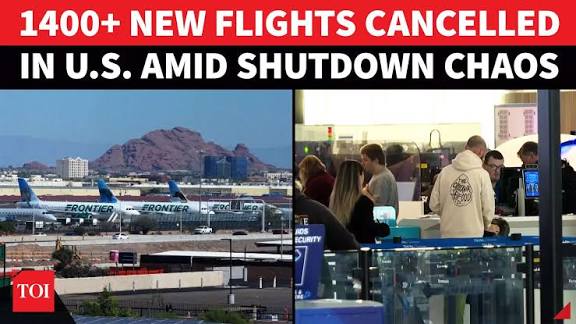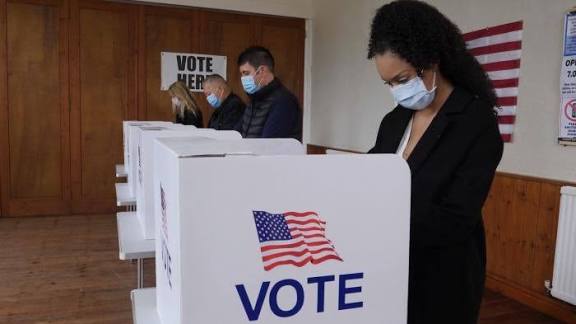US Airports in Crisis: FAA Shortage Causes Nationwide Travel Chaos

According to Reuters, the agency cited security concerns at understaffed control towers as the primary reason for the cuts. Today we will discuss about US Airports in Crisis: FAA Shortage Causes Nationwide Travel Chaos
US Airports in Crisis: FAA Shortage Causes Nationwide Travel Chaos
America’s aviation system is entering one of its most turbulent periods in decades. A growing shortage of air traffic controllers—worsened by an extended federal government shutdown—has thrown operations at major U.S. airports into chaos. From massive delays and flight cancellations to unexpected ground stops, the crisis has exposed deep vulnerabilities in the nation’s air transportation infrastructure.
What began as a staffing gap within the Federal Aviation Administration (FAA) has now escalated into a full-scale national emergency. Airlines are cutting capacity, passengers are stranded, and safety concerns are on the rise. The disruption is so severe that industry leaders warn the effects could linger for years unless immediate structural changes are made.
The Root of the Crisis: FAA Staffing Shortage

The core of the current aviation disaster is a critical shortage of certified air traffic controllers. Even before the government shutdown, the FAA was thousands of controllers short of its staffing goals. Many air traffic control towers and en-route centers were already operating at dangerously low levels, forcing staff into mandatory overtime and extended shifts.
When the federal government shut down, the situation rapidly worsened. Approximately 13,000 controllers have been working without pay, creating intense stress, financial pressure, and the risk of burnout. Some facilities are operating with staffing deficits of 30% to 45%, far below what experts consider safe for handling the volume of U.S. air traffic.
Air traffic control is one of the most high-pressure jobs in the world, requiring extreme focus, rapid decision-making, and constant vigilance. Understaffing increases fatigue and the potential for human error—an alarming combination when thousands of lives depend on every instruction issued from the tower.
Nationwide Travel Chaos: What’s Happening at U.S. Airports
1. Major Airports Are Under Immense Strain
Several of the country’s largest and busiest hubs have been forced to drastically alter operations:
Newark Liberty International Airport experienced such severe controller shortages that United Airlines cut dozens of daily flights to maintain safety margins.
Austin-Bergstrom International Airport implemented a ground delay program stretching across most of the day, with departure delays averaging nearly an hour.
Washington D.C., Orlando, Dallas-Fort Worth, Phoenix, San Francisco, Boston, Nashville, Houston, and multiple regional airports have reported significant slowdowns and capacity constraints.
In many cases, staffing issues at a single control center have caused cascading delays across multiple states, demonstrating how interconnected the aviation system truly is.
2. Flight Delays and Cancellations Surge
The U.S. has witnessed some of its worst travel days in years:
Over 10,000 flights were delayed in one day during a peak crisis period.
More than 2,700 flights were canceled within 24 hours, disrupting travel plans for hundreds of thousands of passengers.
Some facilities reported that staffing-related delays climbed from the normal 5% to more than 50%, an astonishing leap.
On multiple days, passengers faced hours-long waits due to controller shortages, ground holds, and slow arrivals. Airlines have warned that without relief, these disruptions could become the new normal.
3. Ground Stops and Safety Protocols Activated
Because protecting safety is paramount during low staffing periods, the FAA has had no choice but to slow or halt aircraft movements during critical hours. Ground stop alerts were issued at several major airports when controller staffing dipped below safe thresholds.
While these actions prevent accidents, they also create severe operational bottlenecks. A single ground stop at a major hub can delay thousands of passengers and ripple across the entire national airspace system.
The Human Cost: Stress, Fatigue, and Unpaid Work
Behind every delayed flight or grounded aircraft is a workforce under immense pressure.
Air traffic controllers—already working one of the world’s most demanding jobs—are facing:
Mandatory overtime
Six-day workweeks
Double shifts
Missed paychecks due to the shutdown
High fatigue and mental strain
Financial hardship
Some controllers have even taken part-time jobs to support their families. Others have expressed concerns that fatigue could compromise their ability to safely manage air traffic.
The National Air Traffic Controllers Association has warned that the current environment is pushing some of the most experienced professionals toward early retirement or career changes, which could deepen staffing shortages for years.
Systemic Weaknesses Exposed
The ongoing crisis has also revealed longstanding structural issues in the U.S. air traffic control system.
1. Aging Technology and Infrastructure
Many FAA facilities rely on decades-old equipment that requires constant maintenance. When understaffing occurs, even minor technical issues can cause severe delays. Some airports have suffered repeated technology failures that worsen the operational strain.
2. Fragile Training Pipeline
Training a fully certified air traffic controller takes 3 to 4 years, and not all trainees make it through the program. During the shutdown, many trainees were sent home, slowing progress even further.
Any disruption to the pipeline today will be felt in airspace capacity years from now.
3. Retention Challenges
Retention is becoming an even bigger problem than recruitment. High stress, unstable pay during shutdowns, and demanding work conditions are causing seasoned controllers to consider leaving the profession—at a time when every controller counts.
4. Political Gridlock
The prolonged government shutdown has amplified an already fragile situation. Without a funding agreement, the FAA cannot fully staff its training programs, hire new controllers, or pay existing workers. The crisis is now as political as it is operational.
Impact on Airlines, Passengers, and the U.S. Economy
1. Impact on Airlines
Airlines are suffering significant operational disruptions:
Schedule cuts at major hubs
Crew misalignment and overtime costs
Aircraft repositioning challenges
Increased passenger compensation and customer service workloads
Some airlines have even temporarily reduced flights to prevent system overloads.
2. Impact on Passengers
Travelers are encountering:
Long delays
Missed connections
Cancellations
Stressful rebooking processes
Higher travel unpredictability
Many passengers are losing confidence in the reliability of U.S. air travel.
3. Impact on the Economy
Air travel is central to commerce, tourism, trade, and business mobility. Delays and cancellations harm:
Local economies
Hospitality and tourism sectors
Cargo and logistics services
Business travel efficiency
A prolonged staffing shortage could cost billions in lost productivity and consumer spending.
Government Response & Proposed Solutions
1. Calls for Urgent Congressional Action
Industry leaders, unions, and aviation experts are urging Congress to:
End the shutdown immediately
Restore FAA funding
Provide support for hiring and retention
Modernize air traffic control infrastructure
Without legislative action, the crisis could escalate further.
2. FAA’s Long-Term Plans
The FAA has outlined several initiatives to address systemic issues:
Hiring more controllers
Building new control centers
Updating outdated radar and communication systems
Streamlining training programs
But many of these solutions will take years to produce measurable improvements.
3. Safety Remains the Top Priority
Despite the challenges, the FAA continues to emphasize safety above all else. When staffing is inadequate, they reduce capacity rather than take risks. While this frustrates travelers, the policy helps avoid more serious consequences.
What Could Happen If the Crisis Continues
Several potential risks could escalate if the crisis is not resolved:
1. Controller Burnout
Fatigue increases the chance of mistakes in high-pressure environments. Controller burnout could lead to long-term attrition.
2. Long-Term Capacity Decline
If experienced controllers retire early or quit, the shortage could deepen for a decade or more.
3. Rising Safety Concerns
Although no major safety incidents have been linked directly to the shortage, the conditions increase the probability of errors.
4. Erosion of Public Confidence
Repeated travel disruption may cause travelers to reduce flying or choose alternate transportation.
5. Global Competitiveness Risk
If the U.S. fails to modernize, it risks falling behind other countries with more efficient, better-staffed air traffic systems.
Conclusion
The crisis unfolding at U.S. airports is more than a temporary inconvenience—it is a warning signal. America’s aviation system is under severe strain, and the combination of staffing shortages, political gridlock, and aging infrastructure has created a perfect storm of operational challenges.
To restore stability, the U.S. must:
End the government shutdown
Fully fund the FAA
Increase hiring and retention of controllers
Modernize air traffic control technology
Strengthen the training pipeline
Until these steps are taken, delays, cancellations, and travel chaos will likely continue. The future of safe and reliable U.S. air travel depends on swift action and long-term commitment.
How useful was this post?
Click on a star to rate it!
Average rating 0 / 5. Vote count: 0
No votes so far! Be the first to rate this post.
About the Author
usa5911.com
Administrator
Hi, I’m Gurdeep Singh, a professional content writer from India with over 3 years of experience in the field. I specialize in covering U.S. politics, delivering timely and engaging content tailored specifically for an American audience. Along with my dedicated team, we track and report on all the latest political trends, news, and in-depth analysis shaping the United States today. Our goal is to provide clear, factual, and compelling content that keeps readers informed and engaged with the ever-changing political landscape.




